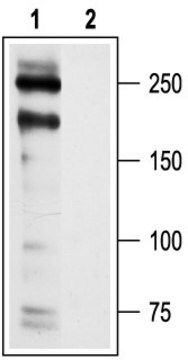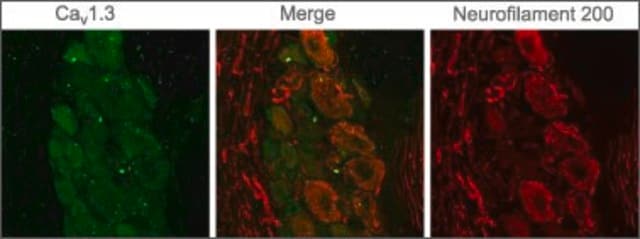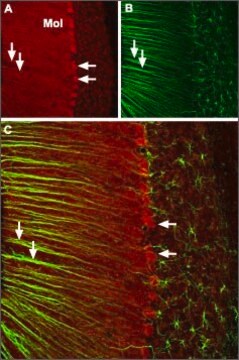C1603
Anti-Calcium Channel (α1C Subunit) (L-type of Voltage-gated Ca2+ Channel) antibody produced in rabbit
affinity isolated antibody
Sinonimo/i:
Anti-CACH2, Anti-CACN2, Anti-CACNL1A1, Anti-CCHL1A1, Anti-CaV1.2, Anti-LQT8, Anti-TS, Anti-TS. LQT8
About This Item
Prodotti consigliati
Origine biologica
rabbit
Livello qualitativo
Coniugato
unconjugated
Forma dell’anticorpo
affinity isolated antibody
Tipo di anticorpo
primary antibodies
Clone
polyclonal
Reattività contro le specie
human, rat, mouse, rabbit
tecniche
immunohistochemistry: suitable using Rat brain sections
western blot: 1:200 using Rat brain and rat heart membranes
N° accesso UniProt
Temperatura di conservazione
−20°C
modifica post-traduzionali bersaglio
unmodified
Informazioni sul gene
mouse ... Cacna1c(12288)
Descrizione generale
Specificità
Immunogeno
Applicazioni
- SDS-PAGE
- western blotting
- coimmunoprecipitation
Immunohistochemistry (1 paper)
Stato fisico
Esclusione di responsabilità
Not finding the right product?
Try our Motore di ricerca dei prodotti.
Raccomandato
Codice della classe di stoccaggio
10 - Combustible liquids
Classe di pericolosità dell'acqua (WGK)
WGK 3
Punto d’infiammabilità (°F)
Not applicable
Punto d’infiammabilità (°C)
Not applicable
Certificati d'analisi (COA)
Cerca il Certificati d'analisi (COA) digitando il numero di lotto/batch corrispondente. I numeri di lotto o di batch sono stampati sull'etichetta dei prodotti dopo la parola ‘Lotto’ o ‘Batch’.
Possiedi già questo prodotto?
I documenti relativi ai prodotti acquistati recentemente sono disponibili nell’Archivio dei documenti.
I clienti hanno visto anche
Il team dei nostri ricercatori vanta grande esperienza in tutte le aree della ricerca quali Life Science, scienza dei materiali, sintesi chimica, cromatografia, discipline analitiche, ecc..
Contatta l'Assistenza Tecnica.







